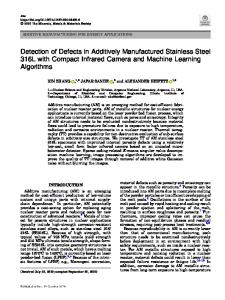Quality Control of Additively Manufactured Metallic Structures with Machine Learning of Thermography Images
- PDF / 2,920,728 Bytes
- 13 Pages / 593.972 x 792 pts Page_size
- 30 Downloads / 327 Views
https://doi.org/10.1007/s11837-020-04408-w Ó 2020 The Minerals, Metals & Materials Society
TECHNICAL ARTICLE
Quality Control of Additively Manufactured Metallic Structures with Machine Learning of Thermography Images XIN ZHANG ,1,2 JAFAR SANIIE,2 WILLIAM CLEARY,3 and ALEXANDER HEIFETZ 1,4 1.—Nuclear Science and Engineering Division, Argonne National Laboratory, Argonne, IL, USA. 2.—Department of Electrical and Computer Engineering, Illinois Institute of Technology, Chicago, IL, USA. 3.—Fuel Fabrication Facility, Westinghouse Electric Company, Columbia, SC, USA. 4.—e-mail: [email protected]
Additive manufacturing (AM) of high-strength metals is currently based on the laser powder bed fusion (LPBF) process, which can introduce internal material flaws, such as pores and anisotropy. Quality control (QC) requires nondestructive evaluation of actual AM structures. Flash thermography is a potentially promising QC technique because it is scalable to arbitrary structure size. However, the detection sensitivity of this method is limited by noise. We investigate separation of signal from noise in thermography images using several machine learning (ML) methods, including new spatial–temporal blind source separation and spatial–temporal sparse dictionary learning methods. Performance of the ML methods is benchmarked using thermography data obtained from imaging stainless steel 316L and Inconel 718 specimens produced by the LPBF method with imprinted calibrated porosity defects. The ML methods are ranked by F-score and execution runtime. The ML methods with higher accuracy require a longer runtime. However, this runtime is sufficiently short to perform QC within a realistic time frame.
INTRODUCTION Additive manufacturing (AM) is an emerging method for cost-efficient production of low-volume custom and unique parts with minimal supplychain dependence.1 In particular, AM potentially provides a cost-saving option for replacing aging nuclear reactor parts and reducing costs for new construction of advanced reactors.2 Metals of interest for passive structures in nuclear applications typically include high-strength corrosion-resistant stainless steel and nickel super alloys, such as stainless steel 316/316L (SS-316L) and Inconel 718 (INC718). Because of their high strength (200 GPa Young’s modulus at room temperature), shaping of these metals into structures with complex geometry is not trivial. AM of such metals, which have a
(Received June 8, 2020; accepted September 22, 2020)
melting range of 1370°C to 1430°C, is currently based on laser powder-bed fusion (LPBF).3,4 Because of the intrinsic features of LPBF, material defects such as porosity and anisotropy can appear in the metallic structure.5 Porosity can be introduced into AM parts due to incomplete melting of the powder particles or insufficient overlapping of the melt pools.6 Oscillations in the surface of the melt pool caused by rapid heating and cooling result in powder ejection and splattering of the melt, resulting in surface roughness and porosity.7–9 Quality control
Data Loading...











